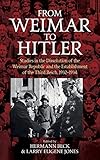From Weimar to Hitler : Studies in the Dissolution of the Weimar Republic and the Establishment of the Third Reich, 1932-1934 / ed. by Larry Eugene Jones, Hermann Beck.
Material type: TextPublisher: New York ; Oxford : Berghahn Books, [2018]Copyright date: ©2018Description: 1 online resource (508 p.)Content type:
TextPublisher: New York ; Oxford : Berghahn Books, [2018]Copyright date: ©2018Description: 1 online resource (508 p.)Content type: - 9781785339172
- 9781785339189
- National socialism -- History
- Social change -- Germany -- History -- 20th century
- HISTORY / Europe / Germany
- 1930s germany
- 20th century
- adolph hitler
- antisemitism
- berlin
- civic
- consolidation of power
- dictatorship
- engaging
- german history
- history
- holocaust
- international history
- miscalculation
- multiple perspectives
- nazi germany
- nazism
- papen cabinet
- political transformation
- politics
- retrospective
- rohm blood purge
- trumpism
- wwii
- 943.085 23
- online - DeGruyter
| Item type | Current library | Call number | URL | Status | Notes | Barcode | |
|---|---|---|---|---|---|---|---|
 eBook
eBook
|
Biblioteca "Angelicum" Pont. Univ. S.Tommaso d'Aquino Nuvola online | online - DeGruyter (Browse shelf(Opens below)) | Online access | Not for loan (Accesso limitato) | Accesso per gli utenti autorizzati / Access for authorized users | (dgr)9781785339189 |
Frontmatter -- Contents -- List of Abbreviations -- Introduction The Nazi Seizure of Power in Historical and Historiographical Perspective -- Chapter 1 Taming the Nazi Beast: Kurt von Schleicher and the End of the Weimar Republic -- Chapter 2 Ausnahmezustand, Staatsnotstandsplan, and Ermächtigungsgesetz: Reappraising Carl Schmitt’s Political Constitutionalism and the Demise of Weimar -- Chapter 3 Ludwig Kaas and the End of the German Center Party -- Chapter 4 The Nazi Seizure of Power in Bavaria and the Demise of the Bavarian People’s Party -- Chapter 5 German Big Business and the National Revolution, 1933–34 -- Chapter 6 Violence against “Ostjuden” in the Spring of 1933 and the Reaction of German Authorities -- Chapter 7 The SA in the Gleichschaltung: The Context of Pressure and Violence -- Chapter 8 Nationalist Socialism against National Socialism? Perceptions of Nazism and Anti-Nazi Strategies in the Circle of the Neue Blätter für den Sozialismus, 1930–34 -- Chapter 9 Nationalism, Socialism, and Organized Labor’s Response to the Dissolution of the Weimar Republic -- Chapter 10 From Collegiality to the Führerprinzip: The 1933 Introduction of the Episcopacy in the Hamburg Landeskirche -- Chapter 11 Friedrich von Bodelschwingh and the Protestant Appeasement of the Nazi Regime, 1933–34 -- Chapter 12 In Search of Allies: Catholic Conservatives, the Alliance of Catholic Germans, and the Nazi Regime, 1933–34 -- Chapter 13 German Youth between Euphoria and Resistance: Political Coercion and the Coordination of German Youth -- Chapter 14 “German Youth, Your Leader!” How National Socialism Entered Elementary Schools in 1933 -- Conclusion Reaffirming the Value of Political History -- Index
restricted access online access with authorization star
http://purl.org/coar/access_right/c_16ec
Though often depicted as a rapid political transformation, the Nazi seizure of power was in fact a process that extended from the appointment of the Papen cabinet in the early summer of 1932 through the Röhm blood purge two years later. Across fourteen rigorous and carefully researched chapters, From Weimar to Hitler offers a compelling collective investigation of this critical period in modern German history. Each case study presents new empirical research on the crisis of Weimar democracy, the establishment of the Nazi dictatorship, and Hitler’s consolidation of power. Together, they provide multiple perspectives on the extent to which the triumph of Nazism was historically predetermined or the product of human miscalculation and intent.
Mode of access: Internet via World Wide Web.
In English.
Description based on online resource; title from PDF title page (publisher's Web site, viewed 25. Jun 2024)


